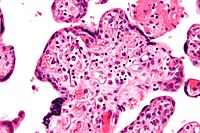
Photo from wikipedia
OBJECTIVE To evaluate the perinatal outcome associated with severe and isolated intrauterine growth restriction (IUGR) diagnosed before 25 weeks and to describe factors related to fetal death. METHODS This retrospective… Click to show full abstract
OBJECTIVE To evaluate the perinatal outcome associated with severe and isolated intrauterine growth restriction (IUGR) diagnosed before 25 weeks and to describe factors related to fetal death. METHODS This retrospective study included singleton pregnancies with an estimated fetal weight (EFW) ≤ 3rd centile between 21 + 0 and 24 + 6 weeks' gestation referred between 2013 and 2020. All fetuses with morphological or chromosomal abnormalities were excluded. We constituted three groups based on perinatal outcomes to highlight poor prognostic factors: live birth, fetal death and termination of pregnancies (TOP). RESULTS We included 98 pregnancies with an overall survival rate of 61.2% (60/98). There were 63.2% (62/98) live births, 24.5% (24/98) TOP, and 12.2% (12/98) fetal death. Of the live births, 27.4% (17/62) of fetuses were born before 32 weeks, and two died in the neonatal period (2/62; 3.2%). The fetal death rate was higher with the presence of an EFW below the first percentile (83.3% of fetal death Vs 33.8% of live births; p=0.002), Doppler abnormalities (83.3% of fetal death Vs 6.4% of live births; p<0.001), and oligoamnios (41.9% of fetal death Vs 11.3% of live births; p=0.05). CONCLUSION Severe growth restriction detected before 25 weeks was associated with poor perinatal outcomes. There were more often EFW <1st percentile, abnormal Doppler and oligoamnios in cases of fetal death compared to live births.
Journal Title: Journal of gynecology obstetrics and human reproduction
Year Published: 2022
Link to full text (if available)
Share on Social Media: Sign Up to like & get
recommendations!